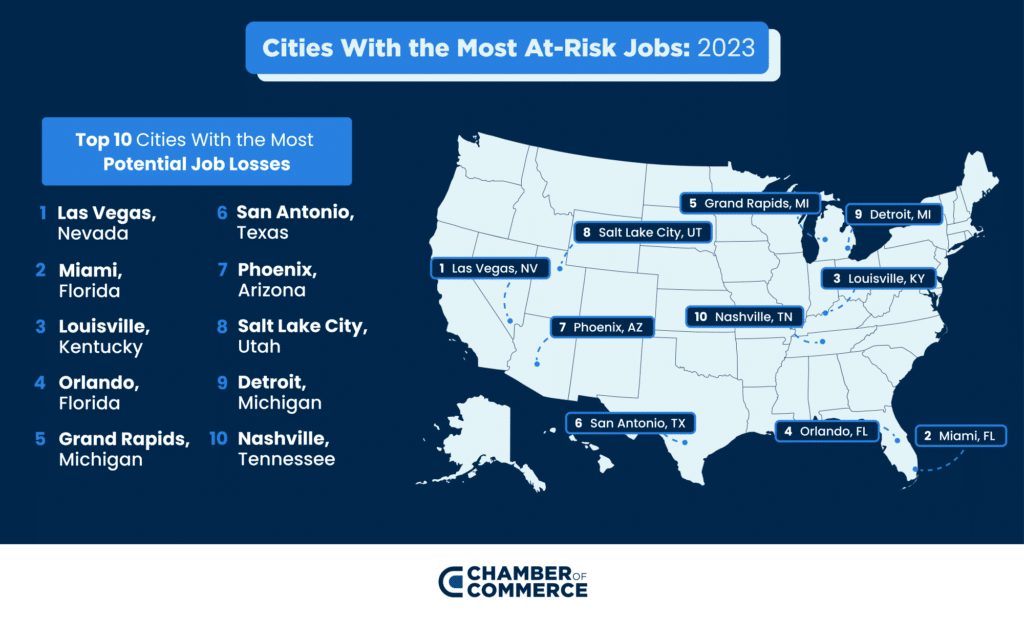From bank tellers and retail workers to software engineers and doctors, no line of work or type of business is entirely immune to artificial intelligence.
Despite AI’s potential to save employers on labor costs, increase productivity and spur overall economic growth, it can also lead to the disruption or loss of millions of jobs throughout the next several years.
In fact, the World Economic Forum (WEF) estimates that approximately 83 million jobs could be automated worldwide by 2027. The recent WEF study surveyed more than 800 companies, which employ 11.3 million workers across 45 countries, to gauge the fastest-growing and fastest-declining jobs. Meanwhile, Goldman Sachs places the estimated number of job losses even higher at 300 million jobs.
But what might AI-related job losses look like in the United States and how many potential jobs could be affected? To answer this question, we analyzed U.S. Bureau of Labor Statistics data, focusing on the top 10 most at-risk occupations from the WEF study, and determined the number of susceptible jobs in major metropolitan areas across the country.
Key findings
- Administrative roles such as record-keeping and cashiers as well as accounting, bookkeeping, factory, and traditional security roles face the largest potential job losses due to AI.
- Las Vegas, Miami, Louisville, Orlando, and Grand Rapids are home to the highest number of at-risk jobs.
- Across the most populated 50 metropolitan areas, more than 10 million jobs fall into the category of “at-risk” occupations.
Where will AI replace the most jobs?

In terms of the top 10 most susceptible occupations, most of these roles are related to administration, such as cashiers, clerks, data entry, accounting, and bookkeeping. According to WEF estimates, more than 26 million record-keeping and administrative jobs could be eliminated by 2027.
Elsewhere, traditional security guards, housekeepers, bank tellers, retail sales, and door-to-door sales are also considered “at-risk” occupations, which have already been declining.
The decline of these occupations has been accelerated by technology and digitalization, which are two factors that will lead to continual job losses within these fields throughout the next five years.
Job losses are also accelerating with the recent introduction of generative AI technology such as Chat CPT, Bard, and DALL-E. According to WEF, this fast-growing technology could make tasks related to reasoning, communication, and coordinating more automatable in the coming years.
Our analysis included the total number of susceptible occupations within the top 50 most populated metropolitan areas across the country. Rankings were based on the percentage of potential job losses within each metro area.
Top five cities with the most at-risk jobs
#1. Las Vegas, Nevada
- Total employed: 1,024,390
- Number of at-risk jobs: 161,840
- Percent of potential job losses: 15.80%
#2. Miami, Florida
- Total employed: 2,623,770
- Number of at-risk jobs: 393,920
- Percent of potential job losses: 15.01%
#3. Louisville, Kentucky
- Total employed: 643,330
- Number of at-risk jobs: 96,420
- Percent of potential job losses: 14.99%
#4. Orlando, Florida
- Total employed: 1,297,460
- Number of at-risk jobs: 190,000
- Percent of potential job losses: 14.64%
#5. Grand Rapids, Michigan
- Total employed: 549,710
- Number of at-risk jobs: 79,910
- Percent of potential job losses: 14.54%
Cities with the fastest declining jobs
Many of the nation’s most susceptible jobs have already been on the decline due to economic factors, digitalization, technology, or a combination.
We took a closer look at the fastest declining jobs in major metro areas by analyzing BLS occupational employment data. Our analysis looked at more than 800 occupations and compared the number of job losses and gains for each of those occupations from 2018 to 2023.
Even though technology such as AI will undoubtedly change and disrupt the workplace for years to come, it’s important to remember that this new technology is also estimated to create more than 69 million jobs worldwide by 2027, according to WEF.
Roles such as data analysts, scientists, machine learning specialists and cybersecurity experts could grow as much as 30% within the next five years. And according to management consulting firm PriceWaterhouseCoopers, global GDP could grow $15 trillion by 2030 due to AI and robotics.
It’s easy to let the fear of the unknown seep in when it comes to AI, but using AI to your advantage could not only protect your job or business, but it could also help it grow.
Whether you’re an employee or a small business owner, taking the right steps now to learn AI and adapt it within your daily work routine can help you properly prepare for the future.
Methodology
To determine our ranking, we considered the most at-risk occupations according to data from the World Economic Forum’s “Future of Jobs Report 2023.” These occupations include accounting, bookkeeping, and payroll clerks; administrative and executive secretaries; assembly and factory workers; bank tellers and related clerks; building caretakers and housekeepers; business services and administration managers; cashiers and ticket clerks; client information and customer service workers; data entry clerks; door-to-door sales workers; news and street vendors, and related workers; security guards; material recording and stock-keeping clerks; postal service clerks; retail salespersons and telemarketers.
Using U.S. Bureau of Labor Statistics employment data, we then analyzed employment numbers for these occupations within the 50 most populated metropolitan areas. Potential job loss estimates are based on the percentage of at-risk jobs within each metro area.
To find each metro area’s top three fastest declining jobs, we compared BLS employment numbers across more than 800 occupations from May 2018 to May 2023.
Sources: U.S. Bureau of Labor Statistics, World Economic Forum, Goldman Sachs, PriceWaterhouseCoopers
Fair Use: Feel free to use this data and research with proper attribution linking to this study.
Media Inquiries: For media inquiries, contact [email protected]
